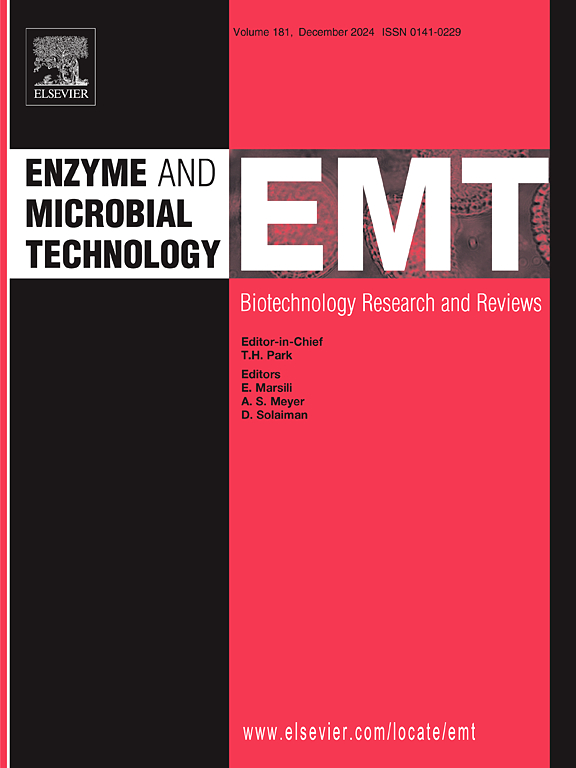Biochemical and structural characterization of a family-9 glycoside hydrolase bioprospected from the termite Syntermes wheeleri gut bacteria metagenome
IF 3.7
3区 生物学
Q2 BIOTECHNOLOGY & APPLIED MICROBIOLOGY
引用次数: 0
Abstract
Glycosyl hydrolases (GH) are enzymes involved in the degradation of plant biomass. They are important for biorefineries that aim at the sustainable utilization of lignocellulosic residues to generate value-added products. The termite Syntermes wheeleri gut microbiota showed an abundance of bacteria from the phylum Firmicutes, a phylum with enzymes capable of breaking down cellulose and degrading lignin, facilitating the use of plant materials as a food source for termites. Using bioinformatics techniques, cellobiohydrolases were searched for in the gut metagenome of the termite Syntermes wheeleri, endemic to the Cerrado. After selecting sequences of the target enzymes, termite gut microbiome metatranscriptome data were used as the criteria to choose the GH9 enzyme sequence Exo8574. Here we present the biochemical and structural characterization of Exo8574, a GH9 enzyme that showed activity with the substrate p-nitrophenyl-D-cellobioside (pNPC), consistent with cellobiohydrolase activity. Bioinformatics tools were used to perform phylogeny studies of Exo8574 and to identify conserved families and domains. Exo8574 showed 48.8 % homology to a protein from a bacterium belonging to the phylum Firmicutes. The high-quality three-dimensional (3D) model of Exo8574 was obtained by protein structure prediction AlphaFold 2, a neural network-based method. After the heterologous expression of Exo8574 and its purification, biochemical experiments showed that the optimal activity of the enzyme was at a temperature of 55 ºC and pH 6.0, which was enhanced in the presence of metal ions, especially Fe2 +. The estimated kinetic parameters of Exo8574 using the synthetic substrate p-nithrophenyl-beta-D-cellobioside (pNPC) were: Vmax = 9.14 ± 0.2 x10−5 μmol/min and Km = 248.27 ± 26.35 μmol/L. The thermostability test showed a 50 % loss of activity after 1 h incubation at 55 °C. The secondary structure contents of Exo8574 evaluated by Circular Dichroism were pH dependent, with greater structuring of protein in β-antiparallel and α-helices at pH 6.0. The similarity between the CD results and the Ramachandran plot of the 3D model suggests that a reliable model has been obtained. Altogether, the results of the biochemical and structural characterization showed that Exo8574 is capable of acting on p-nithrophenyl-beta-D-cellobioside (pNPC), a substrate that mimics bonds cleaved by cellobiohydrolases. These findings have significant implications for advancing in the field of biomass conversion while also contributing to efforts aimed at overcoming challenges in developing more efficient cellulase cocktails.
白蚁肠道细菌宏基因组中9家族糖苷水解酶的生物化学和结构表征
糖基水解酶(GH)是一种参与植物生物量降解的酶。它们对于旨在可持续利用木质纤维素残留物以产生增值产品的生物精炼厂非常重要。白蚁的肠道微生物群显示出丰富的厚壁菌门细菌,厚壁菌门具有能够分解纤维素和降解木质素的酶,有利于白蚁利用植物材料作为食物来源。利用生物信息学技术,在塞拉多地区特有的白蚁Syntermes wheeleri的肠道宏基因组中寻找纤维生物水解酶。选择目标酶序列后,以白蚁肠道微生物组元转录组数据为标准,选择GH9酶序列Exo8574。在这里,我们展示了Exo8574的生化和结构表征,这是一种GH9酶,显示出与底物对硝基苯基- d -纤维素生物苷(pNPC)的活性,与纤维素生物水解酶的活性一致。使用生物信息学工具对Exo8574进行系统发育研究,并确定保守家族和结构域。Exo8574与厚壁菌门细菌的蛋白同源性为48.8%。利用基于神经网络的蛋白结构预测AlphaFold 2方法获得高质量的Exo8574三维模型。Exo8574外源表达及纯化后,生化实验表明,该酶在55℃、pH 6.0条件下活性最佳,且在金属离子,尤其是Fe2 +的存在下活性增强。利用合成底物p-nithrophenyl- β - d -cellobioside (pNPC)估计的Exo8574动力学参数为:Vmax = 9.14 ± 0.2 x10−5 μmol/min, Km = 248.27 ± 26.35 μmol/L。热稳定性测试表明,在55 °C孵育1 h后,活性损失50%。通过圆二色性评价,Exo8574的二级结构含量与pH值有关,在pH值为6.0时,β-反平行和α-螺旋结构的蛋白含量较高。CD结果与三维模型Ramachandran图的相似性表明获得了一个可靠的模型。总之,生化和结构表征结果表明,Exo8574能够作用于对硝基苯- β - d -纤维素生物苷(pNPC),这是一种模拟纤维素生物水解酶裂解键的底物。这些发现对推进生物质转化领域具有重要意义,同时也有助于克服开发更有效的纤维素酶混合物的挑战。
本文章由计算机程序翻译,如有差异,请以英文原文为准。
求助全文
约1分钟内获得全文
求助全文
来源期刊

Enzyme and Microbial Technology
生物-生物工程与应用微生物
CiteScore
7.60
自引率
5.90%
发文量
142
审稿时长
38 days
期刊介绍:
Enzyme and Microbial Technology is an international, peer-reviewed journal publishing original research and reviews, of biotechnological significance and novelty, on basic and applied aspects of the science and technology of processes involving the use of enzymes, micro-organisms, animal cells and plant cells.
We especially encourage submissions on:
Biocatalysis and the use of Directed Evolution in Synthetic Biology and Biotechnology
Biotechnological Production of New Bioactive Molecules, Biomaterials, Biopharmaceuticals, and Biofuels
New Imaging Techniques and Biosensors, especially as applicable to Healthcare and Systems Biology
New Biotechnological Approaches in Genomics, Proteomics and Metabolomics
Metabolic Engineering, Biomolecular Engineering and Nanobiotechnology
Manuscripts which report isolation, purification, immobilization or utilization of organisms or enzymes which are already well-described in the literature are not suitable for publication in EMT, unless their primary purpose is to report significant new findings or approaches which are of broad biotechnological importance. Similarly, manuscripts which report optimization studies on well-established processes are inappropriate. EMT does not accept papers dealing with mathematical modeling unless they report significant, new experimental data.
 求助内容:
求助内容: 应助结果提醒方式:
应助结果提醒方式:


